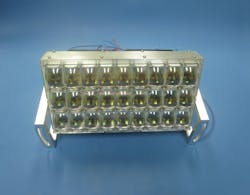Near-IR VCSEL illuminator emits 108 kW of optical power
Military applications that require high-power near-IR illumination will benefit from a vertical-cavity surface-emitting laser (VCSEL)-based illuminator unveiled by Princeton Optronics (Trenton, NJ) that emits 108 kW of optical power at a 1064 nm wavelength. The fan-cooled unit consists of 8 modules, each emitting 16 kW (see photo for individual module). The individual VCSEL arrays in the modules emit 200 W continuous-wave (CW) power and have a chip size of 5 × 5 mm. The electrical-to-optical (wall-plug) efficiency of the individual VCSEL arrays are about 50% and their operation temperature is about 50°C. Cylindrical lenses are located in front of the arrays to tailor the divergence angle to what is desired for the illuminator. The illuminator is operated at a 30 Hz repetition rate, producing pulses with a 1 ms duration.
The module has an overall wavelength spec of ±7 nm for the arrays it contains, which allows for rejection of background light via a narrowband optical filter fitted to the camera used to capture the illuminated scene. This narrow-wavelength illumination capability sets VCSELs apart from other illumination sources, says Chuni Ghosh, CEO of Princeton Optronics. Even so, the speckle from the illuminator is very low due to the arrays of VCSELs and the fact that there are multiple arrays in the module. The illuminator modules were mounted on a curved frame so that the light was focused at the required distance within a certain effective divergence angle. Contact Chuni Ghosh at [email protected].
About the Author
John Wallace
Senior Technical Editor (1998-2022)
John Wallace was with Laser Focus World for nearly 25 years, retiring in late June 2022. He obtained a bachelor's degree in mechanical engineering and physics at Rutgers University and a master's in optical engineering at the University of Rochester. Before becoming an editor, John worked as an engineer at RCA, Exxon, Eastman Kodak, and GCA Corporation.

